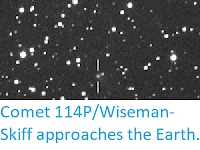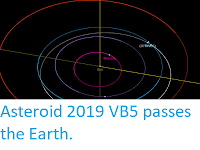Asteroid 2016 AF193 passed by the Earth at a distance of about 15 977 000
km (41.6 times the average distance between the Earth and the Moon, or
10.7% of the distance between the Earth and the Sun), slightly after 9.35 am
GMT on Monday 2 December 2019. There was no danger of
the asteroid hitting us, though were it to do so it would have
presented a significant threat. 2016 AF193 has an estimated
equivalent
diameter of 78-250 m (i.e. it is estimated that a spherical object
with
the same volume would be 78-250 m in diameter), and an object at the
upper end of this range would be predicted to be capable of
passing through the Earth's
atmosphere relatively intact, impacting the ground directly with an
explosion that would be about 4000 times as powerful as the
Hiroshima
bomb. Such an impact would result in an impact crater over 4 km
in
diameter
and devastation on a global scale, as well as climatic effects that
would last years or even decades.
The calculated orbit and current position of 2016 AF193. JPL Small Body Database Browser.
2016 AF193 was discovered on 14 January 2019 by the University of Hawaii's PANSTARRS telescope. The
designation 2016 AF193 implies that it was the 4638th asteroid (asteroid F193 -
in numbering asteroids the letters A-Y, excluding I, are assigned
numbers from 1 to 24, with a number added to the end each time the
alphabet is ended, so that A = 1, A1 = 25, A2 = 49, etc., which means that F193 = 6 + (24 X 193) = 4638)
discovered in the first half of January 2016 (period 2016 A).
2016 AF193 has a 299 day orbital period, with an elliptical orbit tilted at
an angle of 6.45° to the plain of the Solar System which takes in to
0.61 AU from the Sun (61% of the distance at which the Earth orbits the
Sun, and less than the distance at which Venus orbits the Sun) and out to
1.13 AU (13%
further away from the Sun than the Earth). This means that close
encounters between the asteroid and Earth are fairly common, with the
last thought to have happened in February 2016 and the next predicted
in June next year (2020). The asteroid also has frequent close encounters with the planet Venus, with the last though to have happened in March last year (2018) and the next predicted for August next year (2020). Although it does cross the Earth's
orbit and is briefly
further from the Sun on each cycle, 2016 AF193 spends most of its time
closer to the Sun than we are, and is therefore classified as an Aten
Group Asteroid. As an asteroid probably larger than 150 m in diameter
that occasionally comes within 0.05 AU of the Earth, 2016 AF193 is also
classified as a Potentially Hazardous Asteroid.
See also...
Follow Sciency Thoughts on Facebook.







